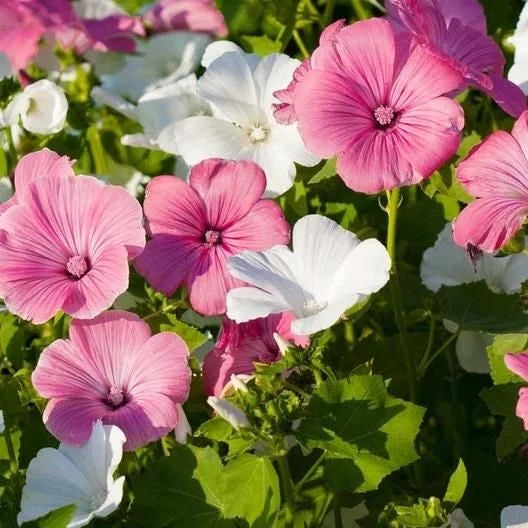Rose Mallow Mixed Color Seeds
Couldn't load pickup availability
Description
Rose Mallow (Hibiscus moscheutos), also known as Hardy Hibiscus, is a stunning perennial plant that produces large, showy blooms with soft, velvety petals. Available in a mix of vibrant colors, these flowers can range from deep reds and pinks to soft whites and purples. Rose Mallow is known for its eye-catching blossoms, which can grow up to 10-12 inches across, making it a striking addition to any garden. This plant thrives in sunny spots and moist, well-drained soil, adding beauty and charm to flower beds, borders, and water gardens. It’s a great choice for gardeners seeking a plant with both ornamental value and ease of care.
Key Features
- Large, Vibrant Flowers: Rose Mallow produces massive blooms in an array of colors, including red, pink, white, and purple, creating a stunning visual display.
- Perennial Growth: This plant is a perennial, meaning it will come back year after year, providing lasting beauty in your garden.
- Adaptable: Tolerant of a variety of soil types, Rose Mallow thrives in both garden beds and near water features like ponds or streams.
- Easy to Grow: With proper care, Rose Mallow is relatively low-maintenance and ideal for beginner to intermediate gardeners.
- Pollinator-Friendly: These flowers attract bees, butterflies, and hummingbirds, helping to enhance the biodiversity of your garden.
- Eye-Catching Blooms: The large, bold flowers make Rose Mallow an excellent choice for focal points in garden landscapes.
Why Choose Rose Mallow Seeds
- Show-Stopping Blooms: The large, colorful flowers are perfect for making a bold statement in your garden. Whether in full sun or near water features, Rose Mallow adds a tropical, exotic feel to your landscape.
- Long-Lasting: As a perennial, Rose Mallow will continue to bloom and thrive for years, providing long-term beauty and interest.
- Low Maintenance: Once established, Rose Mallow is easy to care for and relatively resistant to pests, making it a great option for gardeners of all experience levels.
- Pollinator Attraction: These plants attract bees, butterflies, and hummingbirds, contributing to the health of your garden’s ecosystem.
- Versatile: Rose Mallow is versatile enough for planting in flower beds, garden borders, or alongside water features, making it suitable for a variety of garden designs.
How to Grow and Care for Rose Mallow Seeds
- Planting: Start Rose Mallow seeds indoors 6-8 weeks before the last frost or sow them directly outdoors once the soil temperature has warmed. Plant the seeds 1/4 inch deep in well-draining soil. If starting indoors, keep them in a warm, sunny spot or under grow lights until germination occurs, which usually takes 10-20 days.
- Light Conditions: Rose Mallow requires full sun for at least 6-8 hours per day to thrive. Ensure that the plants are in a location that receives abundant sunlight to encourage strong growth and vibrant blooms.
- Watering: These plants prefer consistently moist soil. Water regularly, especially during dry periods, to keep the soil consistently moist but not waterlogged. They also thrive in moist, well-draining soils and can be planted near water features like ponds.
- Soil: Rose Mallow prefers rich, moist, well-drained soil. If your soil is sandy or not rich in nutrients, consider amending it with organic matter or compost to improve fertility and drainage.
- Temperature: These plants grow best in warm climates with temperatures between 65-85°F (18-29°C). They are hardy in USDA zones 4-9, so be sure to plant them in a zone where they can thrive.
- Fertilization: Apply a balanced, slow-release fertilizer in early spring to promote healthy growth. Alternatively, use a liquid fertilizer once a month during the growing season for better results.
- Pruning: Deadhead spent blooms regularly to encourage more flowering throughout the season. Cut back the plant to the ground in the fall after the first frost to prepare it for winter dormancy.
- Pest Control: While Rose Mallow is relatively pest-resistant, keep an eye out for aphids, whiteflies, or spider mites. If you notice any pests, treat with insecticidal soap or neem oil.
- Winter Care: In colder climates, mulch the base of the plant to protect it from freezing temperatures during the winter months. In regions with frost, Rose Mallow may die back to the ground in winter, but it will regrow from the roots in spring.
Benefits of Growing Rose Mallow Seeds
- Stunning Flower Display: The large, colorful blooms create a striking visual impact in any garden. They work well as focal points in flower beds, borders, or containers.
- Pollinator-Friendly: Rose Mallow flowers attract bees, butterflies, and hummingbirds, contributing to the overall health and biodiversity of your garden.
- Perennial Growth: As a perennial, Rose Mallow will return year after year, providing consistent beauty with minimal effort.
- Low Maintenance: Once established, this plant requires little care, making it a great option for both novice and experienced gardeners.
- Versatile Planting Options: Rose Mallow can be grown in various garden settings, including alongside water features, in flower beds, or in containers. Its versatility makes it ideal for different garden designs.
- Great for Pollinator Gardens: This plant is an excellent choice for creating a pollinator-friendly garden, attracting a wide range of beneficial insects.
This detailed description of Rose Mallow seeds provides all the essential information for planting, growing, and caring for this beautiful flowering plant, ensuring your garden is filled with vibrant, long-lasting blooms year after year.





